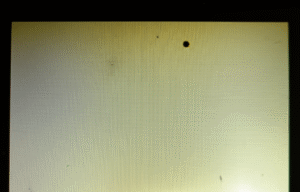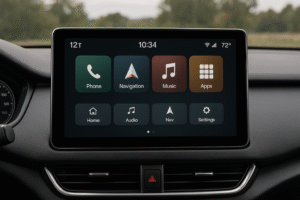
The typical Mean Time Between Failures (MTBF) for commercial LCD modules ranges from 30,000 to 70,000 hours. This equals about 3 to 7 years of continuous use. Real-world results vary based on how the displays are used. MTBF helps you understand how reliable these modules are. It guides choices in buying, maintaining, and planning for LCDs.
What Is MTBF and How Does It Impact System Reliability?

Mean Time Between Failures (MTBF) is a metric used in reliability engineering. It shows the average time between failures for a repairable system. This number helps businesses predict when a system might fail and plan maintenance to avoid downtime. For example, a high MTBF means a system runs longer before breaking, which improves reliability and cuts repair costs(Why Do High-Lumen Lights Fail in Outdoor Environments?).
This metric applies to systems that can be fixed, like factory machines or computer servers. It differs from Mean Time To Failure (MTTF), which is for items that get replaced when they fail, like batteries. Mean Time To Repair (MTTR) measures how long repairs take. In a real project, a team managing a production line used MTBF to schedule machine checkups. They found that machines with an MTBF of 2,000 hours needed maintenance every 1,800 hours to prevent stops. This kept the line running with less interruption.
Here’s a quick list to show how these metrics work:
- MTBF: Time between failures for repairable systems.
- MTTF: Time until failure for non-repairable systems.
- MTTR: Time to fix a failed system.
What Is the Definition of MTBF?
MTBF means Mean Time Between Failures. It measures the average time a repairable system operates before it fails again. You calculate it by dividing total running time by the number of failures. For instance, if a system runs for 10,000 hours and fails 5 times, its MTBF is 2,000 hours. This gives a clear picture of how reliable the system is.
In practice, MTBF guides maintenance planning. A team working on a water pump with an MTBF of 1,500 hours checked it every 1,300 hours. This stopped failures before they happened, saving time and money. Companies use MTBF to keep critical systems, like servers or engines, in good shape without waiting for breakdowns.
How Does MTBF Differ from MTTF and MTTR?
MTBF tracks the time between failures for repairable systems. MTTF measures how long a non-repairable system lasts before it fails for good, like a light bulb. fibre MTTR is the time it takes to repair a system after it fails. For example, a repairable printer might have an MTBF of 5,000 hours, while a disposable battery has an MTTF of 1,000 hours. If the printer’s MTTR is 1 hour, repairs are quick.
In a project, an IT team used MTBF for servers they could fix and MTTF for hard drives they replaced. They also tracked MTTR to reduce downtime after server failures. This approach helped them decide which systems to repair and which to replace, keeping costs low and systems running. Knowing these metrics makes planning more effective.
- MTBF: Time between failures for repairable systems.
- MTTF: Time to failure for non-repairable systems.
- MTTR: Time to repair a failed system.
How MTBF Is Calculated?
MTBF, or Mean Time Between Failures, is a key metric used to measure the reliability of a system. It tells us the average time a system operates before it fails, helping teams plan maintenance and predict downtime. Below, we’ll break it down into three main parts: the basic formula, the statistical model, and the data sources.
Basic Formula
The simplest way to calculate MTBF is with this formula:
MTBF = Total Uptime ÷ Number of Failures
- Total Uptime: The total time the system is running and functional (in hours, days, etc.).
- Number of Failures: How many times the system stops working during that period.
Example:
Imagine a machine runs for 10,000 hours and fails 5 times. Plugging the numbers into the formula:
MTBF = 10,000 ÷ 5 = 2,000 hours
This means, on average, the machine runs for 2,000 hours before failing. A higher MTBF indicates better reliability.
Practical Use:
A factory might track a robot’s uptime at 15,000 hours with 3 failures, giving an MTBF of 5,000 hours. They could then schedule maintenance every 4,500 hours to avoid breakdowns.
Statistical Model
For a deeper analysis, MTBF ties into a statistical model that assumes failures occur at a constant rate over time. This rate is called the failure rate (λ), and it’s the inverse of MTBF:
λ = 1/MTBF
- λ (Failure Rate): The number of failures per unit of time (e.g., failures per hour).
- MTBF: The average time between failures (in the same time units).
Example:
If a system has an MTBF of 1,000 hours, its failure rate is:
λ = 1 ÷ 1,000 = 0.001 failures per hour
This means there’s a 0.001 chance of failure in any given hour. Engineers use this to predict reliability over specific periods.
Practical Use:
For a generator with an MTBF of 2,500 hours, the failure rate is:
λ = 1 ÷ 2,500 = 0.0004 failures per hour
If a power outage lasts 100 hours, this λ helps calculate the risk of failure, guiding decisions like whether to add a backup system.
- MTBF: 1,000 hours → λ = 0.001 failures/hour
- MTBF: 2,000 hours → λ = 0.0005 failures/hour
- MTBF: 5,000 hours → λ = 0.0002 failures/hour
Data Sources
To calculate MTBF, you need data on uptime and failures. This data can come from three main sources:
- Lab Tests
- Controlled experiments simulate real-world conditions to measure how long a system lasts before failing.
- Example: A lab might test a motor for 2,800 hours to estimate its MTBF.
- Standards (e.g., MIL-HDBK-217F)
- Industry standards provide pre-calculated MTBF values for common components, based on averages and historical data.
- Example: MIL-HDBK-217F might list an MTBF of 2,500 hours for a specific pump.
- Field Data
- Real-world usage data from actual systems in operation. This is often the most accurate for specific cases.
- Example: A company tracks 100 machines for a year and finds an MTBF of 3,000 hours.
Practical Use:
A team compared field data (3,000 hours) with lab tests (2,800 hours) and MIL-HDBK-217F (2,500 hours) for their machines. They chose the field data for maintenance planning because it reflected their unique conditions, reducing downtime effectively.
Which Source to Use?
- Lab Tests: Good for new systems with no real-world history.
- Standards: Quick estimates when data is scarce.
- Field Data: Best for accuracy in specific environments.
Vendor Tier Breakdown (30,000 / 50,000 / 70,000 Hours)
Vendors classify industrial displays into tiers based on MTBF, which measures how long a display is expected to work before failing. The tiers—30,000 hours (about 3.4 years), 50,000 hours (about 5.7 years), and 70,000 hours (about 8 years)—cater to different needs and budgets.
Tier Examples
- 30,000-Hour MTBF (Entry-Level)
A small warehouse used these displays to track inventory. The lower cost fit their budget, and occasional failures were manageable with spare units on hand. - 50,000-Hour MTBF (Mid-Range)
A car parts manufacturer chose these for its assembly line. They needed reliable displays but couldn’t justify premium costs, accepting rare downtime as a trade-off. - 70,000-Hour MTBF (Premium)
An airport control tower installed these to manage flight data. The high reliability ensured no interruptions, as even brief failures could risk safety.
| Tier | MTBF (Hours) | Typical Use Case | Example Industry |
|---|---|---|---|
| Entry-Level | 30,000 | Budget-friendly, low-risk | Warehouse |
| Mid-Range | 50,000 | Balanced cost and reliability | Manufacturing |
| Premium | 70,000 | High-stakes, critical tasks | Airport Control |
Typical MTBF Values for Commercial LCDs
Now that we understand what MTBF (Mean Time Between Failures) is and how it’s calculated, let’s explore typical MTBF values for commercial LCDs and what they mean in practical terms. These values vary across three quality tiers—standard, advanced, and premium—reflecting different levels of reliability for various applications. We’ll also look at how to convert these hours into years based on operational duty cycles.
Standard Tier: ~30,000 Hours
The standard tier of commercial LCDs has an MTBF of approximately 30,000 hours. These displays are typically found in consumer-grade products, such as TVs or computer monitors used in homes or offices. They are designed to balance cost and reliability for everyday use, where continuous operation isn’t usually required.
For example, an office might use standard tier LCDs for employee workstations. If these monitors are on for 8 hours a day, they could last a long time before needing replacement, making them a cost-effective choice for non-critical settings.
Advanced Tier: ~50,000 Hours
The advanced tier offers an MTBF of around 50,000 hours. These LCDs are suited for professional environments, such as digital signage in retail stores or displays in conference rooms. They are built to handle longer daily usage than standard tier displays, though not necessarily 24/7 operation.
Imagine a retail store using advanced tier LCDs for digital menus. These screens might run for extended hours each day, and their higher MTBF ensures greater durability compared to standard options, reducing maintenance needs over time.
Premium Tier: ~70,000 Hours
The premium tier boasts an MTBF of about 70,000 hours. These LCDs are engineered for critical applications where reliability is paramount, such as medical imaging, air traffic control, or industrial control rooms. They are often used in settings where displays run continuously, and failure could have serious consequences.
For instance, a hospital might choose premium tier LCDs for its monitoring systems. The high MTBF minimizes the risk of downtime, ensuring consistent performance in life-or-death situations.
Converting to Years & Operational Duty Cycles
To translate MTBF into years of service, we need to consider the duty cycle—the number of hours per day the LCD is in use. This varies by application: a home TV might run a few hours daily, while a control room display might operate 24/7.
The formula to calculate the time to failure in years is:
Let’s take a standard tier LCD with an MTBF of 50,000 hours as an example:
- If used 24 hours a day:
- If used 8 hours a day:
| Tier | MTBF (hours) | 24/7 Usage (years) | 12 hours/day (years) | 8 hours/day (years) |
|---|---|---|---|---|
| Standard | 30, 000 | 3.4 | 6.8 | 10.2 |
| Advanced | 50,000 | 5.7 | 11.4 | 17.1 |
| Premium | 70,000 | 8 | 16 | 24 |
Note: These are average values assuming a constant failure rate. Actual lifetimes may vary due to factors like environmental conditions, component quality, and maintenance practices. MTBF is a statistical measure, not a guaranteed lifespan.
Factors Influencing MTBF
Mean Time Between Failures (MTBF) is influenced by the operating environment, usage patterns, and component quality. These factors determine how long systems like LCDs, servers, or industrial equipment operate before failing, helping users plan maintenance and improve reliability(The Effect of Temperature on the Functional Performance of LCD Modules).
The operating environment, including temperature, humidity, and vibration, can degrade components. Usage patterns, whether intermittent or continuous, affect wear rates. Component quality, such as LED vs. CCFL backlights, impacts durability. For example, a digital signage system in a humid environment saw its MTBF drop by 15% due to poor ventilation, prompting environmental controls.
This table outlines how each factor affects MTBF:
| Factor | Impact on MTBF | Mitigation Strategy |
|---|---|---|
| Operating Environment | High temperature or humidity reduces lifespan | Use cooling systems or dehumidifiers |
| Usage Patterns | Continuous use accelerates wear | Schedule downtime for intermittent use |
| Component Quality | Low-quality electronics fail faster | Choose LED backlights or robust circuits |
How Does the Operating Environment Affect MTBF?
The operating environment, including temperature, humidity, and vibration, significantly impacts MTBF. Harsh conditions accelerate component degradation, reducing system reliability.
In a factory, LCDs exposed to high temperatures (above 40°C) and vibration from machinery had an MTBF reduction of 20%. Installing cooling units and vibration dampeners restored reliability. Stable environments, with moderate humidity (40-60%) and low vibration, extend component life.
Key environmental considerations:
- Temperature: Keep below 35°C for optimal performance.
- Humidity: Avoid levels above 70% to prevent corrosion.
- Vibration: Use mounts to minimize mechanical stress.
How Do Usage Patterns Influence MTBF?
Usage patterns, whether intermittent or continuous, affect MTBF by altering component wear. Continuous operation increases stress, while intermittent use allows recovery periods, extending lifespan.
A retail store using LCDs for 24/7 signage saw an MTBF of 40,000 hours, but switching to 12-hour daily operation increased it to 55,000 hours. Intermittent use reduces thermal stress and power cycling damage, improving reliability.
Factors in usage patterns:
- Continuous use: Suits critical systems but lowers MTBF.
- Intermittent use: Extends lifespan for non-critical applications.
- Power cycling: Minimize frequent on/off to reduce wear.
How Does Component Quality Impact MTBF?
Component quality, such as LED vs. CCFL backlights or electronics, determines MTBF. Higher-quality components resist failure, enhancing system durability(LED Backlight Technology Analysis: CCFL, WLED, DLED, ELED, and FALED).
In a hospital, LCDs with LED backlights achieved an MTBF of 80,000 hours, compared to 50,000 hours for CCFL-based displays. LEDs consume less power and generate less heat, while robust electronics withstand stress. Selecting high-grade components improves reliability.
Key aspects of component quality:
- Backlights: LEDs outperform CCFLs in efficiency.
- Electronics: Use durable circuits for longevity.
- Materials: High-quality connectors reduce failure rates.
What Are the Limitations of MTBF?
Mean Time Between Failures (MTBF) is a useful reliability metric, but it has limitations. It is a statistical average, not a guarantee, and excludes early-life failures, wear-out periods, and gradual performance degradation. These constraints affect its accuracy for systems like LCDs, servers, or machinery.
MTBF provides an average operational time between failures but does not predict individual system lifespans. It overlooks initial defects and end-of-life wear, and it does not capture performance declines. For example, a digital signage system with a 50,000-hour MTBF failed early due to a manufacturing defect, highlighting the need for complementary metrics like failure rate analysis.
| Limitation | Description | Implication |
|---|---|---|
| Statistical Average | MTBF is an average, not a guarantee | Unpredictable individual failures |
| Excludes Early-Life & Wear-Out | Ignores initial defects and aging | Missed failure patterns |
| Ignores Degradation | Does not track performance decline | Underestimated maintenance needs |
Why Is MTBF Only a Statistical Average?
MTBF is a statistical average, meaning it estimates average reliability but does not guarantee a specific lifespan for any system. Individual units may fail sooner or later than the MTBF value.
In a data center, servers with a 100,000-hour MTBF showed varied failure times, with some lasting 120,000 hours and others failing at 80,000 hours. This variability prompted redundancy planning to mitigate downtime. MTBF relies on large sample sizes, making it less precise for single units.
Why Does MTBF Exclude Early-Life Failures and Wear-Out Periods?
MTBF focuses on the useful life phase of a system, excluding early-life failures (caused by defects) and wear-out periods (due to aging components). This limits its ability to predict full lifecycle reliability.
A manufacturing plant using LCDs with a 70,000-hour MTBF faced early failures from faulty backlights, which MTBF did not account for. Similarly, wear-out failures increased after 5 years. Combining MTBF with burn-in testing and end-of-life monitoring improved reliability predictions.
How Does MTBF Ignore Gradual Performance Degradation?
MTBF does not account for gradual performance degradation, where system efficiency declines without outright failure. This can mislead users about reliability for applications like displays or electronics.
In a retail setting, LCDs with a 50,000-hour MTBF showed brightness loss after 3 years, affecting image quality but not counted as failures. Regular performance checks helped adjust maintenance schedules. MTBF focuses on complete failures, not functional decline.
What Are Supplementary Reliability Metrics?

| Metric | Purpose | Application |
|---|---|---|
| L₇₀ Backlight Life | Tracks brightness decline to 70% | Display longevity assessment |
| FIT Rate | Measures failures per 10⁹ hours | Component reliability analysis |
| Bathtub Curves | Maps failure patterns over time | Lifecycle failure prediction |
| MTTR | Assesses repair time impact | Maintenance and downtime planning |
HUA XIAN JING produces 60,000-10,0000 hours of small and medium-sized LCD modules, which are used by our customers in a variety of applications such as Smartwatches, Home Appliances, Industrial HMI, Electric Vehicles, Ebikes, Boats, and more.
What Is the L₇₀ Backlight Life Rating?
L₇₀ backlight life rating measures the time until an LCD’s backlight brightness drops to 70% of its original level, indicating display reliability. It is critical for applications like medical imaging or public signage.
Uses of L₇₀:
- Plan display replacements based on brightness needs.
- Select backlights for specific use cases.
- Monitor image quality in critical applications.
What Is the FIT Rate?
FIT rate (Failures In Time) measures failures per 10⁹ hours, providing a precise metric for component reliability in systems like circuits or sensors. Lower FIT rates indicate higher durability.
Applications of FIT rate:
- Assess component quality for high-reliability systems.
- Compare suppliers based on failure data.
- Predict failure risks in precision equipment.
Reliability (Bathtub) Curves
Reliability curves, or bathtub curves, show how failure rates change over a system’s life. They have three phases:
Early failures: High but decreasing rates, often due to defects.
Useful life period: Low, constant failure rates (where MTBF is most relevant).
Wear-out: Increasing failures as parts age.
For instance, a fleet of delivery trucks might experience early failures from manufacturing issues, then stable operation, and finally wear-out as engines degrade. To identify the current phase, analyze failure data: decreasing rates suggest early failures, steady rates indicate useful life, and rising rates point to wear-out.
FAQ
Does MTBF include gradual brightness loss in backlights?
No, MTBF tracks outright failures, not slow luminance decay. The L₇₀ rating covers brightness loss by indicating when backlight output drops to 70 % of initial levels.
What does it mean if an LCD module has a higher MTBF but still fails early?
A higher MTBF means fewer expected failures, but some early failures can happen due to manufacturing defects or harsh use that MTBF cannot predict.
How should I compare LCD modules from different vendors if their MTBF values are similar?
Check other reliability metrics such as backlight L₇₀, FIT rate, warranty terms, and real field data to make a well-rounded comparison.
Does using a display for fewer hours each day increase its lifespan compared to the MTBF value?
Yes, if you use a display for fewer hours each day, the total service years will be longer than continuous operation suggests.
What can cause real-world MTBF to be lower than the factory MTBF?
Real-world MTBF can be lower due to high temperature, humidity, vibration, power surges, or poor maintenance—all of which increase the risk of failure outside ideal test conditions.







